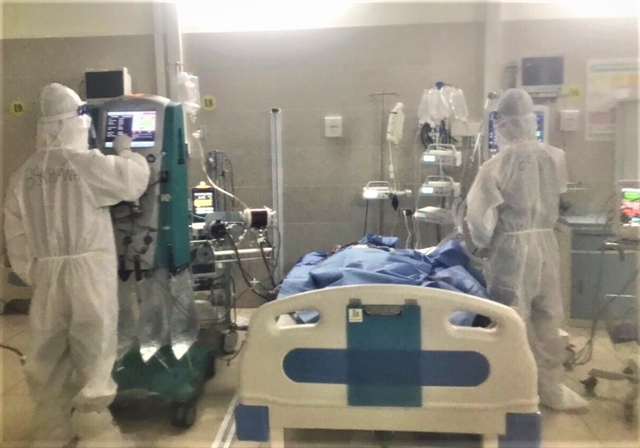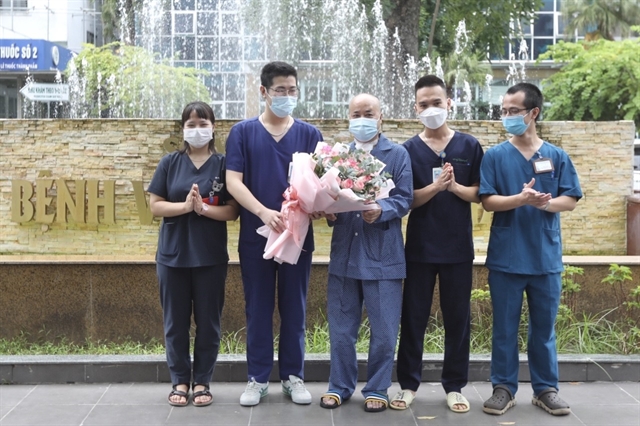 Society
Society

Early last month, Hà Nội’s Thanh Nhàn Hospital for the first time used Extracorporeal membrane oxygenation (ECMO) to treat a critically-ill COVID-19 patient. He recovered from COVID-19 and was discharged from the hospital a few days ago.

|
| Patient Hoàng Văn Ngọc was placed on life support for two weeks at Thanh Nhàn Hospital. — Photo courtesy of the hospital |
HÀ NỘI — Early last month, Hà Nội’s Thanh Nhàn Hospital for the first time used Extracorporeal membrane oxygenation (ECMO) to treat a critically ill COVID-19 patient.
The patient, Hoàng Văn Ngọc, 48, from Hoàng Mai District, was placed on ECMO for two weeks after all other forms of heart and lung support failed. Ngọc recovered from COVID-19 and was discharged from the hospital a few days ago.
“His recovery is a source of happiness not only for himself but also Thanh Nhàn Hospital’s health workers, particularly those who directly provided him with whole-hearted medical treatment and care,” said vice director of the hospital Nguyễn Thị Lan Hương.
Hương said that Ngọc’s recovery was a motivation for the hospital’s medical workers in treating COVID-19 patients.
When using ECMO to treat Ngọc, Thanh Nhàn Hospital’s doctors received professional support from their colleagues at leading hospitals including the National Hospital for Tropical Diseases and Bạch Mai Hospital, Hương said.
“When Ngọc was placed on ECMO, health workers were at his bedside almost all the time, closely caring for his breathing and monitoring his blood,” she said.
ECMO works by temporarily drawing blood from the body to allow artificial oxygenation of the red blood cells and removal of carbon dioxide with a machine.
Doctor Lê Văn Dẫn, who directly provided Ngọc treatment, said that the patient was transferred to Thanh Nhàn Hospital on August 3.
“He is young, does not have any underlying health conditions but his COVID-19 development turned critical very fast,” Dẫn said, adding that medical techniques like dialysis and a high-flow nasal cannula (HFNC) failed.
“As Ngọc quickly suffered respiratory failure with serious lung damage, we decided to use ECMO for him on the night of August 8 as the last hope to save him,” said Dẫn who is deputy head of Thanh Nhàn Hospital’s Intensive Care Department.
“It took more than three hours to place the ECMO on him. However, after that, the oxygen concentration in his blood was low and kept decreasing,” he said, adding that medical workers had to stay next to him all the time to adjust the machine and ensure sufficient oxygen supply.
“Three days later, Ngọc’s condition started improving with increasing oxygen concentration,” Dẫn said.
“Despite Ngọc’s improved health indicators, doctors worried as his lung injuries were already in the stage of solidified lesions and fibrosis.”
“We continued to use the ECMO and adsorption systems with aggressive therapeutic measures. Gradually, the patient's condition showed signs of improvement with improved oxygen index and more stable blood pressure. We had to gradually reduce sedation to assess the patient's consciousness and movement of his hands and feet,” Dẫn said.
“This was the time we could see the patient's chance of survival," doctor Dẫn said.
Ngọc said that recovering from COVID-19 was like being born for the second time.
“I could not remember clearly how I was taken to Thanh Nhàn Hospital. At that time, I could hardly breathe. It was like someone was holding my nose tightly,” he said.
All he could do at that time was to try to inhale deeply as per doctors' instructions.
“I told myself to keep trying, following doctors or I would die,” he said, adding that at some moments, he was unable to get any oxygen.
“When I felt I could not go on anymore, I gave up. I was lying quietly, motionless, but in my mind, I thought about my death,” Ngọc remembered.
As soon as Ngọc fell into a coma, he was provided intensive care and placed on ECMO.
“When I woke up after the coma, I was so happy to see everything and people around as if I started a new life,” Ngọc said.
A few days later, he said that he still had difficulties breathing and he had to practise daily with support from medical workers.
His health condition started to improve. He felt much better with his breathing becoming regular.
Ngọc tested positive for SARS-CoV-2 with a very high viral load after spending 12 days in a concentrated quarantine area in Thanh Trì District.
Ngọc was taken to Đống Đa District Hospital for COVID-19 treatment. After only two days at the hospital, he was transferred to Thanh Nhàn Hospital as he had strong reactions to SARS-CoV-2 with breathing difficulty, respiratory failure and lung consolidation. His computerised tomography (CT) scan results at that time showed that 80 per cent of his lungs were damaged. Before getting COVID-19, Ngọc reportedly had no underlying medical problems. — VNS

|
| Hoàng Văn Ngọc (centre) and the medical team in charge of his treatment at Thanh Nhàn Hospital on the day of his discharge (September 17, 2021). — VNA/VNS Photo Minh Quyết |